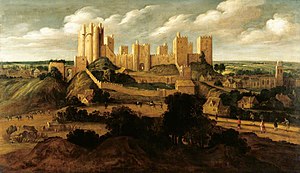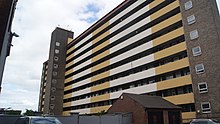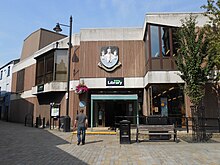Pontefract
| Pontefract | |
|---|---|
| Town | |
West Yorkshire | |
| Ambulance | Yorkshire |
| UK Parliament | |
Pontefract is a historic market town in the
Etymology

At the end of the 11th century, the modern
History
Neolithic
In 2007 an extension of Ferrybridge Henge – a Neolithic henge – was discovered near Pontefract during a survey in preparation for the construction of a row of houses. Once the survey was complete, construction continued.[8]
Roman
The modern town is situated near an old
The period of Yorkshire's history between the demise of the Viking king, Eric Bloodaxe, in 954 and the arrival of the Normans in 1068 is known as the Anglo-Scandinavian age. The modern township of Pontefract consisted of two Anglo-Scandinavian settlements, Tanshelf and Kirkby. In Yorkshire, place-name locations often contain the distinctive Danish '-by' i.e. Kirkby and today, the major streets in Pontefract are designated by the Danish word 'gate' e.g. Bailygate.
The Anglo-Scandinavian township, Tanshelf, recorded as Tateshale, Tateshalla, Tateshalle or Tatessella in the 'Domesday Book' is today occupied by the town of Pontefract. The Anglo-Saxon Chronicle made a reference to Tanshelf in 947 when King Eadred of England met with the ruling council of Northumbria to accept its submission. King Eadred did not enjoy Northumbria's support for long, and a year later the kingdom voted Eric Bloodaxe King of York.[9]
When the Domesday survey was commissioned by
Medieval

After the
1086 and was later rebuilt in stone. The de Lacys lived there for more than two centuries[12] and were holders of the castle and the Honour of Pontefract from 1067[13] until the death of Alice de Lacy in 1348.[14]
King Richard II was murdered at the castle in 1400.[15][16] Little is known of the nature of his demise; Shakespeare may have "adjusted" the facts for his own purposes.[17] At least three theories attempt to explain his death:[18] either he was starved to death by his keepers, he starved himself to death or he was murdered by Sir Piers (Peter) Exton on 14 February 1399 or 1400.[19]
Early modern history
In Elizabethan times the castle and the town were both referred to as "Pomfret".[15] William Shakespeare's play Richard III mentions the castle:
Pomfret, Pomfret! O thou bloody prison,
Fatal and ominous to noble peers!
Within the guilty closure of thy walls
Richard the second here was hack'd to death;
And, for more slander to thy dismal seat,
We give thee up our guiltless blood to drink.[15]

Pontefract suffered throughout the
The castle ruins are publicly accessible.Governance

For local government purposes the town lies in the City of Wakefield administered by Wakefield Council. It is divided into two electoral wards, Pontefract North and Pontefract South. Pontefract South was represented by two Labour councillors and one Conservative councillor and North ward represented by three Labour councillors in 2022.[24]
From 1978 to 1997, ex-miner and former
She held a number of positions in the Labour governments up to 2010 and Shadow Cabinet roles (most notably Shadow Home Secretary) after the election of that year, but returned to the back benches after the Labour leadership election of 2015. Pontefract and Castleford was merged with the Normanton constituency in a boundary change before the 2010 general election
The seat, which had a history of mining and industry, has returned Labour MPs at general elections. Yvette Cooper polled 59.5% of the vote in the 2017 general election and 48.1% of the vote in the 2019 general election.
Economy
Pontefract has been a market town since the Middle Ages; market days are Wednesday and Saturday, with a small market on Fridays. The covered market is open all week except Sundays. Numerous pubs can be found in the town centre in particular; for example: Beastfair Vaults, the Liquorice Bush, the Red Lion, the Malt Shovel and the Ponty Tavern. A Wetherspoons opened on Horsefair in 2010. It is said by some that Pontefract once held a record for being the town with the highest number of pubs per square mile in the UK,[25][26] but this is likely an urban legend, and the title is held by another town.[27]

The town has a
Close by is the site of the former coal-fired Ferrybridge power station, although the local coal mines largely closed in the 1990s, which contributed to high unemployment in the local area. The final colliery, Prince of Wales Colliery, closed in August 2002.[30] has since been redeveloped into a large housing estate named after the colliery.[31]
There are four supermarkets in Pontefract, including a Tesco and Morrisons that are located opposite each other and an Asda, which was originally a Kwik Save store, and Aldi both a short distance outside the town centre. The secondary schools in the town are Carleton High School in Carleton and the King's School on Mill Hill Lane, both for pupils aged 11–16. A sixth-form college, New College, Pontefract, is located on Park Lane.
Services
The old Pontefract General Infirmary on Southgate (pictured) was a general hospital; it is the place at which serial killer Harold Shipman began to murder his elderly patients. Beneath this building is an old hermitage, open to the public on certain days. Pontefract Museum, from which the hermitage schedule can be obtained, is in the town centre, housed in the former Carnegie library.[32]
A new hospital was built on Friarwood Lane and opened in July 2010, with the new name of Pontefract Hospital; there is now a modern hospital building. Near to the hospital is Friarwood Valley Gardens, a rose garden, a sensory garden, a pinhole camera (formerly an aviary and earlier a Georgian gambling den) and an avenue of cherry trees.


The local police force is West Yorkshire Police, with the town's neighbourhood policing team situated at the new fire station on Stumpcross Lane. The original police station in Sessions House Yard has been demolished since the divisional headquarters for the Wakefield District opened in Normanton and the neighbouring magistrates' court has moved to Leeds, following the closure of the Wakefield and Pontefract courts.
Fire cover is provided by
Ambulance cover is provided by Yorkshire Ambulance service, whose depot is situated in neighbouring town, Castleford

The Territorial Army, Army Cadets and Air Training Corps all have a presence within the town and are based at the historic Barracks building on Wakefield Road. It now houses a Rifles Regiment Recruitment team.
Media, arts and entertainment
Local news and television programmes are provided by BBC Yorkshire and ITV Yorkshire. Television signals are received from the Emley Moor TV transmitter. [33]
Local radio stations are
The local newspaper is the Pontefract and Castleford Express.
Drinking venues include The Red Lion, the Green Dragon, the Tap and Barrel, The Broken Bridge (Wetherspoons), the Malt Shovel, Beastfair Vaults and the Ponty Tavern (formally The Blackmoor Head) or Blacky in local terms. In August 2012, one of Pontefract's oldest but most prestige nightclubs, Kiko's, re-opened its doors to the public after being closed since 2007, then closed again in 2013 due to the building being too far away from the town and other nightlife spots. Kiko's once hosted many notable performances back in the 1970s and 80s from notable bands such as The Bay City Rollers. As of 2022, the building is now vacant and severely damaged inside awaiting revival, venue change or demolition.
Novelist Jack Vance, in the "Demon Princes" cycle has named the capital of Aloysius, the main planet in the Vega system, after Pontefract. The hero of the series, Kirth Gersen, has his residence there.
Pontefract made local and national newspapers in April 2020, with a range of art which lay tribute to the key workers and NHS during the coronavirus outbreak. The art was painted by a local mural artist, Rachel List.[35]
Sport
The town is home to many sports including rugby, football and squash. Prominent squash players Lee Beachill and James Willstrop both train at Pontefract Squash Club. Notable institutions are horse racing at Pontefract Racecourse and Featherstone Rovers, the area's professional rugby league club.
Pontefract Racecourse is the longest continuous horse racing circuit in Europe at 2 miles 125 yards (3,333 m; 16.57 furlongs).[36] It stages flat racing between the end of March and the end of October. A new sports centre is located at Pontefract Park which opened on 12 April 2021, which replaces the old swimming pool located on Stuart Road.[37] Two-time European Masters Champion weightlifter Martyn Riley is from Pontefract.[38]
Pontefract has its own non-league football club, Pontefract Collieries F.C., which was founded in 1958 and plays adjacent to the former Prince of Wales Colliery off Beechnut Lane. The team, known locally as "Ponte Colls" play in the Northern Premier League Division One North West (correct as of the 2021–22 season). Pontefract is also home to the Pontefract Knights rugby league football club.
Pontefract RUFC is based at Moor Lane, Carleton.[39] It runs three senior sides as well as a number of junior and girls teams.[40] Rugby Union has been played in the town since the 19th century when Pontefract won the Yorkshire Cup.
Pontefract used to boast two cricket clubs, Lakeside CC (based in Pontefract Park) and Pontefract CC (adjacent to Pontefract Collieries FC), but by 2002 neither of these clubs were still in existence, leaving the town without its own club despite giving its name to the Pontefract and District Cricket League. Nowadays cricketers must travel to clubs in neighbouring towns and villages, with the closest being Hundhill Hall Cricket Club based in the nearby village East Hardwick.
Transport
Pontefract lies in close proximity to the A1 and the M62. Access from the A1 is via a junction at the nearby village of Darrington, while access from the M62 is via Junction 32 (also for Castleford) and Junction 33 (also for Knottingley).
Bus transport is provided by Arriva Yorkshire, operating from Pontefract bus station as the town's main hub.
There are three railway stations in the town.
The closest airport is Leeds Bradford.
Notable people

- Darren Appleton (1976–) Professional pool player, 9 ball world champion, 10 ball world champion.
- Thurstan of Bayeux, (c.1071–1140), archbishop, died in Pontefract.
- Richard de Pontefract (?–1320?), Dominican friar
- High Sheriff of Yorkshire, MP for Pontefract in the Short Parliament, and Royalistsoldier
- Happy Parliament
- antiquaryand surgeon
- British armygeneral
- John Smyth (1748–1811), MP for Pontefract
- Jesse Hartley (1780–1860), civil engineer and Superintendent of the Concerns of the Dock Estate, Liverpool; built the Albert Dock and many other parts of Liverpool Docks
- Charles Coleman (1807–1874), English painter
- Isaac Cole (1886–1940), rugby union and league player who represented England
- Edward Upward (1903–2009), novelist, lived in Pontefract from 2004 until his death in 2009
- Barbara Castle (1910–2002), Labour Party politician
- John Poulson (1910–1993), architectural designer and businessman
- Don Robinson (1932–2017), 1954 Rugby League World Cup winning rugby league footballer who represented Great Britain, Wakefield Trinity, Leeds, and Doncaster
- Mal Kirk (1936–1987), wrestler
- Margaret Drabble (1939–), novelist, was evacuated to Pontefract during WW2[41]
- Harvey Proctor (1947–), Conservative Member of Parliament[42]
- Mick Jackson (1947–), musician, writer of "Blame It on the Boogie"[43]
- Kevin Moreton (1959–), actor known for Coronation Street
- (2014–2019)
- Huddersfield Town
- Helen Baxendale (1970–), actress known for Cold Feet, Friends, and Cuckoo
- Paul Newlove (1971–), English rugby league footballer who played in the 1980s, 1990s, and 2000s
- Dave Smith (1971–), professional darts player from Knottingley, Wakefield, West Yorkshire
- Robert Hanby (1974–), former footballer
- Dexter Tucker (1975–), footballer
- cricketer who represented Yorkshire, Middlesex, and England. Former coach of the England Men's Cricket team
- Jamie Davis (1981–), actor best known for his roles in Footballers' Wives, Hex, and currently in Casualty as Max Walker
- Rob Burrow (1982–2024), former rugby league footballer with Leeds; he also has represented both England and Great Britain
- Toby Kebbell (1982–) actor known for "Black Mirror", "RocknRolla", "Dawn of the Planet of the Apes", "Warcraft", and "Kong: Skull Island"
- Jamie McCombe, (1983–), footballer who currently plays for Doncaster Rovers
- Paul Green (1983–), footballer who plays for Oldham in the English Football League
- James Willstrop (1983–) squash player and gentleman. Attended Ackworth School and in 2012 became World No.1 in squash by beating David Palmer.
- England
- Ben Parker (1987–), former footballer who played for Leeds United and represented England U19
- Oliver Hindle(1988–), artist and musician, best known for his band project Superpowerless
- Max Litchfield (1995–), swimmer, silver medallist in the 400m medley at the European Long Course Championships
- Joe Litchfield (1998–), swimmer and brother of Max
- Joe Westerman, rugby league footballer
- Dr Harold Shipman spent some time working here.[44]
See also
Notes
- ^ "Pontefract South Ward population 2011". Neighbourhood Statistics. Office for National Statistics. Retrieved 2 March 2016.
- ^ "Pontefract North Ward population 2011". Neighbourhood Statistics. Office for National Statistics. Retrieved 2 March 2016.
- ^ Padgett 170
- ^ Eric Houlder, Ancient Roots North: When Pontefract Stood on the Great North Road, (Pontefract: Pontefract Groups Together, 2012) p.7.
- ^ Orderic Vitalis, Ecclesiastical History of England, 2:27.
- ^ Ayto & Crofton
- ^ Frank Barlow, William I and the Norman Conquest (London: The English Universities Press, 1965) p.95. David Crouch, The Normans: The History of a Dynasty (London: Hambledon and London, 2002) p.105
- ^ "Ferrybridge Henge extension discovered in West Yorkshire". Culture24. 30 August 2007. Retrieved 7 December 2009.
- ^ Towns in Anglo-Saxon West Yorkshire Archived 13 February 2015 at the Wayback Machine. Settlements in Anglo-Saxon West Yorkshire. Retrieved 30 August 2014.
- ^ Hey
- ^ a b Fletcher 16–17
- ^ Padgett 54
- ^ Padgett 55
- ^ Padgett 85
- ^ a b c d "Yorkshire's Castles: Pontefract Castle"; H2G2.com, Not Panicking Ltd.
- ^ Padgett 106
- ^ Holmes 373
- ^ Holmes 373, 374
- ^ Holmes 374
- ^ a b c d Padgett 166–169
- ^ Page, William, ed. (1974). "Houses of Cluniac monks: Priory of Pontefract". A History of the County of York: Volume 3. London. pp. 184–186. Retrieved 3 October 2022 – via British History Online.
{{cite book}}: CS1 maint: location missing publisher (link) - ^ Madden, Frederic; Bandinel, Bulkeley (1 May 1835). Collectanea Topographica Et Genealogica. J. B. Nichols and son. p. 103. Retrieved 1 May 2019 – via Internet Archive.
pontefract levet.
- ^ Early Yorkshire Charters: being a collection of documents anterior to the thirteenth century made from the public records, monastic chartularies, Roger Dodsworth's manuscripts and other available sources; edited by William Farrer. 3 vols. Edinburgh: Printed for the editor by Ballantyne, Hanson & Co., 1914–16
- ^ "Your Councillors by Ward". Wakefield Council. Retrieved 18 June 2016.
- ^ Wollerton, Alison. "Pontefract". Pontefract Heritage Group. Retrieved 7 July 2020.
It has been said that Pontefract once held a world record for having the highest number of pubs per square mile.
- ^ Krasaukas, Vincent. "The Partynice Guide to Pontefract". Partynice Magazine. Retrieved 7 July 2020.
it is believed that the town now has the highest concentration of pubs in the whole of the UK.
- ^ "Britain's Pub Capitals". Liberty Games. Retrieved 7 July 2020.
- ^ Rebecca Smithers (30 July 2012). "Liquorice to grow again in Pontefract". The Guardian. Retrieved 27 October 2016.
- ^ "The Home of Liquorice". Farmer Copleys. 2015. Archived from the original on 28 October 2016. Retrieved 27 October 2016.
- ^ Wainwright, Martin (31 August 2002). "Britain's oldest mine closes". The Guardian. Retrieved 13 July 2020.
- ^ "Prince of Wales, Pontefract | A Project by Harworth Group plc". Harworth. Retrieved 27 December 2021.
- ^ "Free Public Carnegie Library - Pontefract" (PDF). wakefield.gov.uk. Retrieved 3 October 2022.
- ^ "Emley Moor (Kirklees, England) Full Freeview transmitter". UK Free TV. 1 May 2004. Retrieved 20 September 2023.
- ^ "5 Towns FM Radio Online". Internetradiouk.com. Retrieved 20 September 2023.
- ^ Frame, Nick; Hale, Olivia (9 April 2020). "'I never expected this'-Pontefract Artist's surprise as NHS tributes are shared across the world". Pontefract and Castleford Express. Retrieved 14 April 2020.
- ^ "Course Details – Pontefract Racecourse". Archived from the original on 21 August 2008. Retrieved 4 July 2008.
- ^ Spereall, David (16 March 2021). "Pontefract leisure centre set for April 12 opening". YorkshireLive. Retrieved 15 December 2021.
- ^ "Pontefract's Martyn Riley celebrates second European Masters title". Wakefield Express. 29 December 2020. Retrieved 20 January 2021.
- ^ "Ilkley 25 Pontefract 3 Match Report. Millard Leads but Frustrations Continue". www.pontefractrufc.com. Retrieved 31 January 2024.
- ^ "Pontefract RUFC teams". www.pontefractrufc.com. Retrieved 31 January 2024.
- ^ "My Yorkshire: Margaret Drabble". The Yorkshire Post. Retrieved 30 April 2019.
- ISBN 9781785900594– via Google Books.
- ^ "Winter chills, boogie nights and dark side of the moon". Halifax Courier. 28 December 2010. Retrieved 30 April 2019 – via PressReader.
- ^ "Town haunted by memory of young Harold Shipman". The Independent. 22 January 2005. Retrieved 29 January 2022.
Sources
- Ayto, John; Crofton, Ian. Brewer's Britain & Ireland. Weidenfeld & Nicolson.
- Fletcher, J. S. (1993) [1917]. Memorials of a Yorkshire Parish (facsimile). Leeds: Old Hall Press.
- Hey, David. Medieval South Yorkshire.
- Holmes, Richard, ed. (1985) [1887]. The Sieges of Pontefract Castle (facsimile reprint). Leeds: Old Hall Press. ISBN 0-946534-02-0.
- Mills, A. D. Oxford Dictionary of British Place-Names. Oxford University Press.
- Padgett, Lorenzo (1993) [1905]. Chronicles of Old Pontefract (facsimile). Leeds: Old Hall Press.
- "Pontefract's Martyn Riley celebrates second European Masters title". Wakefield Express. 29 December 2020. Retrieved 20 January 2021.


